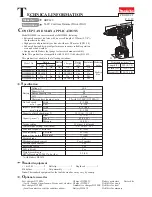
3
HOW TO USE THE DRILL
GENERAL DRILLING
1.
Verify that the drill bit is securely gripped in the chuck. (See “INSTALLING AND REMOVING
DRILL BIT”).
2.
Set the reversing switch (C) Fig. 1 for clockwise rotation.
Hold the workpiece securely in a vise, or clamp it in place prior to starting the
drilling operation.A loose workpiece may spin and cause bodily injury.
3.
Locate the exact center of the space for the hole to be drilled. Use a center punch to make a
small dent in the workpiece.
4.
Place the tip of the drill bit in the dent made by center punch, hold the drill square with the
workpiece, and start the motor.Apply steady, even pressure to keep the drill bit cutting. Too
little pressure will keep the bit from cutting and dull the edges due to excessive friction.
Too much pressure may cause the bit to break or overheat, resulting in bodily
injury or damaged drill bits.
If the drill stalls or becomes jammed in the workpiece, the torque can cause the
tool to twist. BE ALERT and brace yourself agaist this twisting action.
5.
If the drill stalls or becomes jammed in the workpiece, release the trigger immediately.
Do not squeeze the trigger “ON” and “OFF” in an attempt to free the drill
bit. – This action will damage the motor.. Try reversing the direction of
rotation.
6.
Reset the direction before drilling.
7.
Reduce the pressure on the drill just before the bit cuts through the work to avoid splintering
the wooden workpiece or stalling in metal.
8.
When the bit has completely penetrated the workpiece and is spinning freely, withdraw it from
the work while the motor is still running, then turn the drill “OFF”.
DRILLING WOOD
The following instructions apply In addition to the instructions listed under “GENERAL DRILLING”:
1.
To prevent overheating of the bits and burning the workpiece, withdraw twist drills from
wood frequently to clear the flutes of chips and debris.
2.
If you use a backing block to keep the back of the workpiece from splintering, clamp it
securely in place. If you do not use a backing block with spade or auger bits, ease up the
pressure as soon as the bit point breaks through the workpiece, and complete drilling of the
hole from the opposite side.
DRILLING METAL
The following instructions apply in addition to the instructions listed under “GENERAL DRILLING”
Jamming of a bit is more likely to occur when drilling into a metal workpiece
than when drilling into any other material.
1.
Use only good quality, sharp, high-speed, steel twist bits.
2.
Start drilling slowly and gradually increase the speed as the drill cuts. The harder the
material, the slower the speed required. The softer the material, the faster the speed.
3.
When drilling a large hole, first drill a smaller hole and then enlarge it to size.
4.
The use of a lubricant such as oil on the drill point helps keep the bit cool, increasing the
drilling action and prolonging the drill bit life.


























